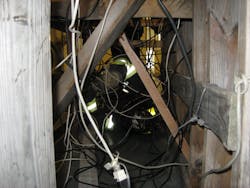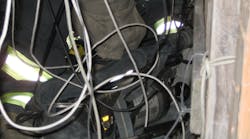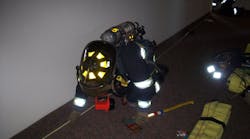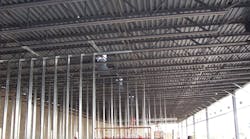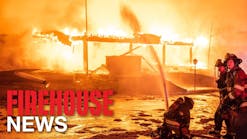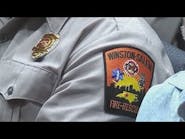Basic Survival Skills and the Probationary Firefighter - Part 3
So far in Parts 1 and 2, we have discussed the core basics of firefighter safety and survival that every new or probationary firefighter must develop and attempt to master over the course of their fire-service careers. There’s so much to learn and so much to master, as it relates to this topic. It’s impossible to absorb it all and become proficient at each and every safety and survival skill in just a few short months. This is why your continued training and study is so critical.
Today, we seek to answer the question, “What skills should I have a working knowledge of?” Every probationary firefighter should leave their basic training with a certain degree of confidence, that in the event something went wrong, they can help themselves or at the very least direct assistance to themselves quickly.
This article covers basic survival skills. Each of the skills and techniques are highlighted and can form the basics of any survival program. Each topic is covered briefly and is designed to point out techniques that a member should have mastery of. For each skill discussed below, your next action is to explore each of these in depth. This can be part of a continuous company training program or possibly devoting several days of training at a fire academy for one specific topic.
These topics are each of great value, but by no means are the only techniques. A good, quality survival program leaves you with the knowledge that you can begin helping yourself at any emergency.
Team Effort
Before we begin talking about techniques all members must be familiar with, it is critical to emphasize that firefighting is a team effort. Our safety and survival is enhanced when a sufficient amount of competent personnel, who are properly equipped, are available.
Some tactics and techniques that directly relate to firefighter safety and survival are beyond the probationary firefighter’s ability. For example, an incident commander has a leading roll in keeping his or her members safe from harm. Just some of these precautions include the following:
Adequate scene lighting, both inside and outside
Effective, adequate, and controlled ventilation removes combustible and poisonous gases, reduces the danger of flashover and backdraft, and increases visibility. Ventilation is not an afterthought; it must be considered often and adjusted as needed.
- A strong incident command system (ICS) where accountability is provided for all responders
- A rapid intervention company (RIC) or companies. This must be more than just a “check in the box.” An RIC is a sufficient amount of highly trained and competent personnel (at least half a dozen) who are properly equipped and capable of going into action instantly!
- Two sustained water supplies (redundancy enhances survival)
- An attack line of appropriate diameter and flow to prevent the danger of flashover. The unburned combustible gases overhead are just looking to ignite. With enough heat and oxygen, the potential exists for members to be incinerated! A charged hoseline must be staffed and protecting the members conducting operations inside the building. In most instances, it will be positioned between the life hazard and the fire. A well-placed attack line protects members from extreme forms of fire behavior.
- A backup line of equal to or greater diameter than the attack line. The backup line provides the same or more water in the event the attack line encounters difficulty (i.e., a burst length, loss of water supply, severe fire conditions, etc.)
- Progress reports. Division and Group Supervisors and/or firefighters and fire officers in key positions (roof, rear of the building, exposures, etc.) must give periodic reports to the Incident Commander (IC). The quality of Information, Intelligence, and Reconnaissance all directly affect whether people will live or die. These key players become the IC’s eyes and ears (see Figure 1).
- A sufficient tactical reserve of resources ready to expand the IC’s strategy if conditions rapidly change
- A 360-degree size-up so the IC knows what the building looks like and what conditions are being faced, inside, outside, and all around including the roof.
- Control of utilities (gas, water, and electric) prevents additional dangers and threats to survival
- Proactive approach to firefighter safety. An IC at the top of his game will always be proactive when it comes to the safety of his firefighters. For example, creating additional egress points such as forcing open multiple doors or laddering multiple sides of the building all aid in survival. This is being proactive. Saving a firefighter’s life doesn’t have to be a dramatic rescue; it can be as simple as having the rear door open, thus allowing for an immediate escape.
- To our engine and ladder company chauffeurs, you are responsible for bringing the team safely to the scene…therefore slow down and stop at stop signs and red lights. Even consider yielding to green lights and double-checking the intersections. During peak periods of fire activity, apparatus may be responding from areas where you normally don’t expect them. Expect the unexpected and drive defensively!
There are countless other points that will also enhance firefighter safety. It is therefore vital that your leaders also be at the top of their game and well versed in fire behavior and building construction. This has a great deal to do with firefighter survival.
Individual Skills and Techniques
Firefighter safety and survival can be dramatically altered through the implementation of the actions described above. Nevertheless, every member has to be able to implement safety and survival skills instantly. What are these skills and techniques that all members must be capable of performing?
- Proper wearing of PPE and SCBA. It sounds simple, but many injuries are attributed to not wearing proper gear. Wear your equipment as it is designed to be worn; the protection it offers you is very significant.
- Seatbelts! A great tip for reducing the chance that you will be injured or killed is to always wear your seatbelt! We respond to many more incidents than just building fires. There is always the chance of someone hitting your apparatus or the chance that circumstances (evasive driving due to another driver’s incompetence, ice, etc.) will cause the apparatus to careen out of control and end up on its side. Your seatbelt is a great insurance policy and limits the number of firefighter injuries and deaths annually.
- Air Management. Our SCBA’s allow us to survive in very hostile environments, but the air supply is finite; it will run out! Many SCBA’s have visual indicators (heads-up display) that allow members to be constantly aware of their air supply. As a good rule of survival, constantly monitor your air supply. Two good rules of thumb are, first, you want to consider the last quarter of your air supply as an emergency reserve. In other words, you want to be out of the building before your low-air alarm sounds. The second rule is air usage. If you entered a large-area occupancy and it took you 10 minutes and three-quarters of your air supply to get to where you are, you do not have enough air to escape! Therefore, always be in the habit of monitoring your air supply in any type of occupancy. Remember, if you used half of your air to get to a certain point, you need at least that to get out. Use great caution and practice frequently with air management techniques.
- Personal size-up. Every firefighter and fire officer conducts a size-up at every incident. A size-up is a process whereby a member looks at potential threats to life safety and incident stabilization. For a probationary firefighter, his or her size-up will include hazards that directly affect them and their team such as fire location and behavior, building construction, type of occupancy, and building area and size. The size-up will answer questions such as where are the egress points (doors, windows, fire escapes, attached buildings, etc.). A firefighter’s size-up never stops. The fireground is dynamic and always evolving…so must be your size-up.
- The exceptional textbook, Fire Officer’s Handbook of Tactics 3rd Edition, by retired Deputy Assistant Chief John Norman, offers significant amounts of not only tactical information, but also information as it relates to safety and survival. The author identifies three key considerations as it relates to survival. From page 249 of his textbook, Norman identifies three rules of firefighter survival:
- Always know where your escape route is
- Never put yourself in a position where you have to depend on someone to come and get you. o
- Always know where your second escape route is
These points are clear and concise and to the point. Each point relies on you conducting a thorough and continuous size-up.
- Being able to transmit a Mayday. A key consideration in getting resources to you quickly is to call for help the moment you think you have a problem! The instant you think you are in danger (i.e., you are lost, trapped, disoriented, or injured), you must transmit a Mayday! A Mayday transmission requires all other members to clear the air immediately! Your Mayday transmission must provide critical information to those who can help you. As a minimum:
- Give your location; be as descriptive as you can be
- Identify who you are
- Identify the nature of your emergency
- Make a request for any specific resources that you need to help you
- Identify your air supply remaining
For example, “Mayday – Mayday – Mayday, Firefighter Smith to Command. Myself and my partner have become disoriented and are lost in the cellar of the fire building near the Charlie side. We have less than half of our air remaining.”
This statement at least provides critical information to begin a rescue. The RIC and the IC know that there are two members who are lost in the cellar somewhere near the rear of the building. We know that their air supply is very limited and must be augmented. A short statement such as this will allow the RIC to mobilize using a search rope, begin in an area where the members are reporting themselves to be, and bring supplemental air to aid the lost members. Furthermore, other members may be operating nearby and have heard the Mayday transmission and can render immediate assistance. Critical information must be passed up and down the chain of command to constantly paint an accurate picture.
Many departments teach the easy to remember acronym LUNAR (location, unit, name, assignment, and resources needed). Each part of the LUNAR acronym identifies key information needed after the Mayday is transmitted. The Mayday transmission is an important skill that every new firefighter must know how to use. At the very least it can send out help to you as soon as you say it!
Remember, the very moment you think you are in danger, transmit the Mayday. Don’t wait until it’s too late (see Figure 2). Your air supply is limited and a rescue is a time-consuming process.
Summary
This article begins to break the ice and identify key elements of firefighter survival. The next part in the series will include additional skills and techniques that every firefighter must know. Safety and survival requires constant training and effort. Remember, these are not buzzwords but rather techniques and skills that are insurance policies. More next time …
References
- Norman, John. Fire Officer’s Handbook of Tactics 3rd Edition, Penwell Publications, 2005.
ARMAND F. GUZZI JR. has been a member of the fire service since 1987. He is a career fire lieutenant with the City of Long Branch, NJ, Fire Department and is the deputy director of the Monmouth County, NJ, Fire Academy where he has taught for over 20 years. He has a masters degree in management and undergraduate degrees in fire science, education, and business administration. View all of Armand's articles here. He can be reached via e-mail at [email protected] or [email protected].

Armand Guzzi | Firehouse.com Contributor
Armand F. Guzzi, Jr. has been a member of the fire service since 1987. He recently retired a career fire lieutenant with the City of Long Branch, NJ, Fire Department and is the deputy director of the Monmouth County, NJ, Fire Academy where he has taught for over 20 years. He has a Master's degree in management and undergraduate degrees in fire science, education, and business administration. View all of Armand's articles here. He can be reached via e-mail at [email protected] or [email protected].
